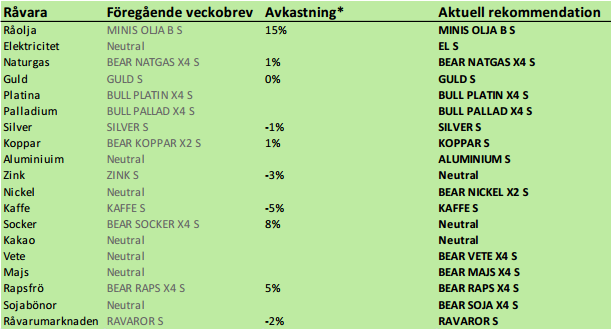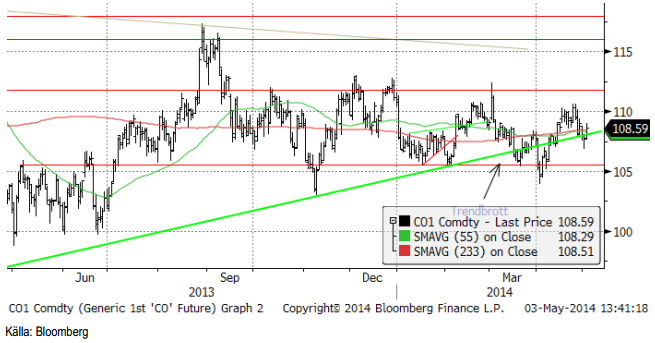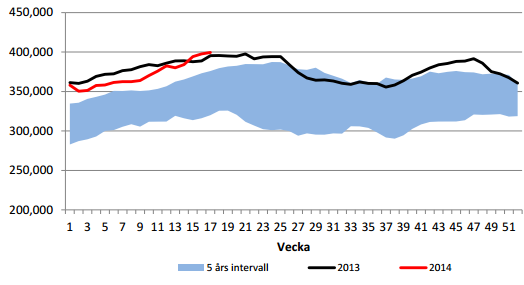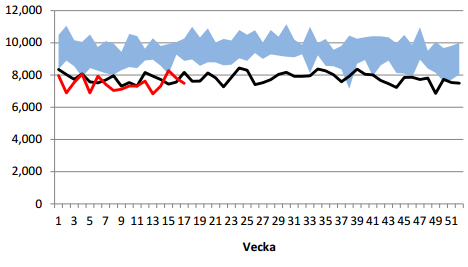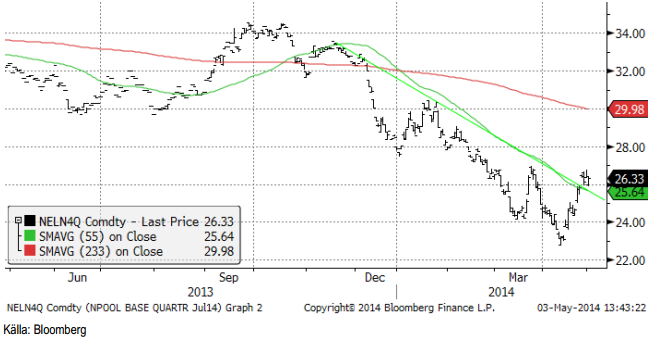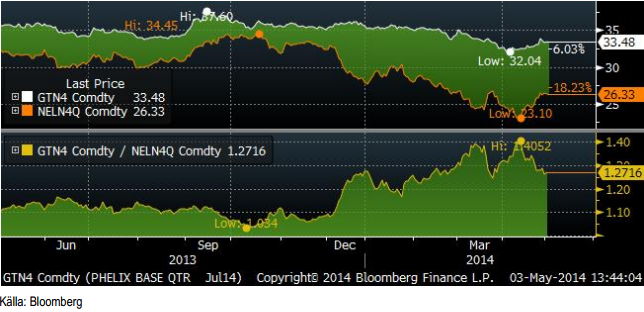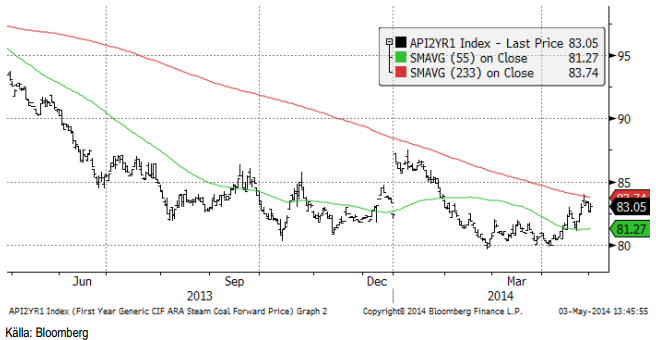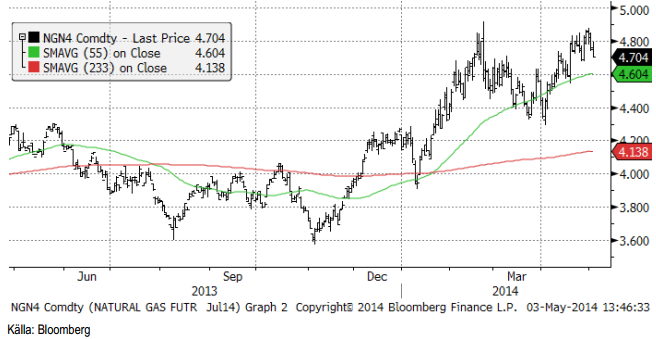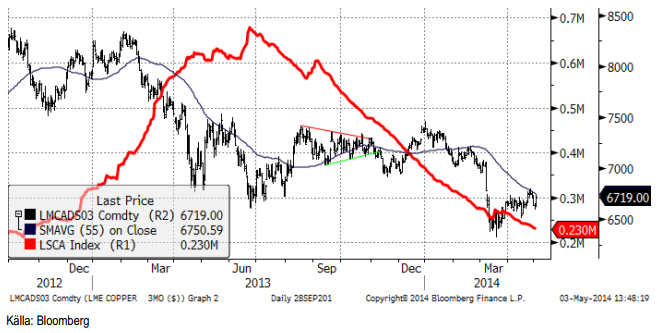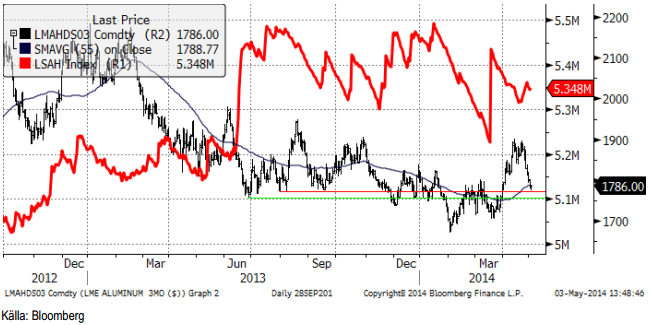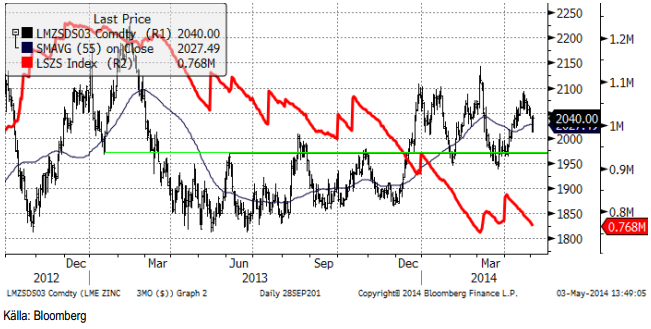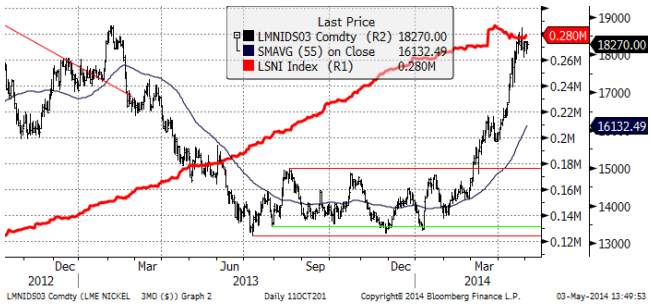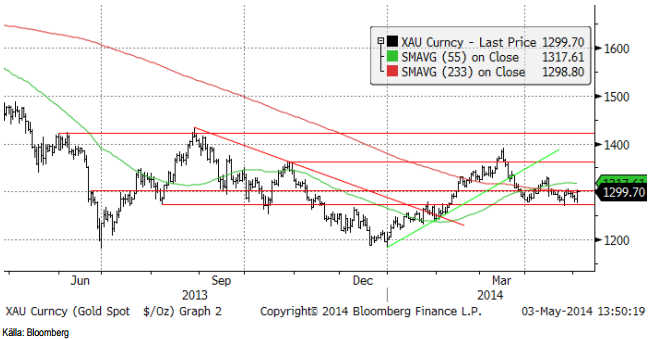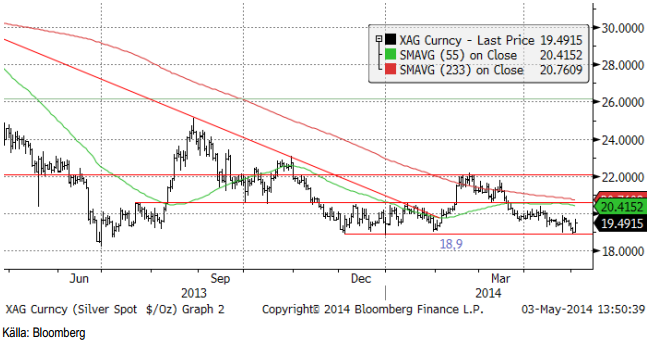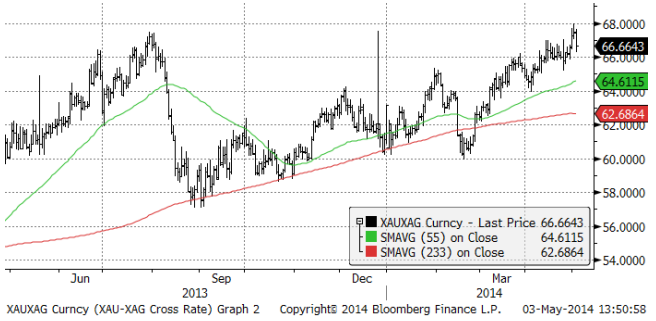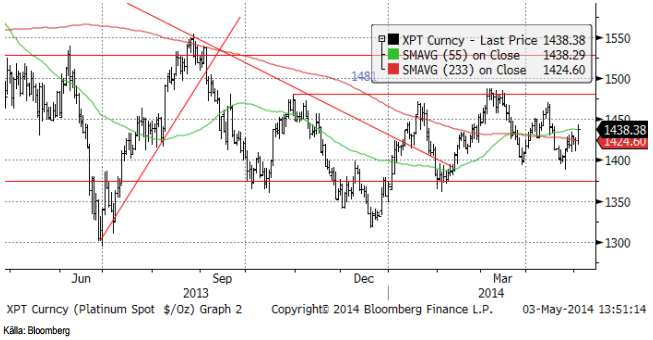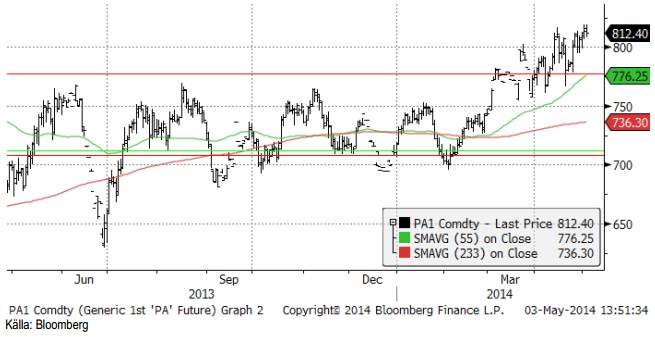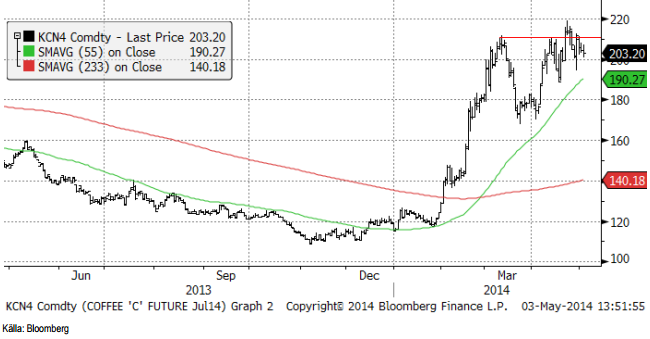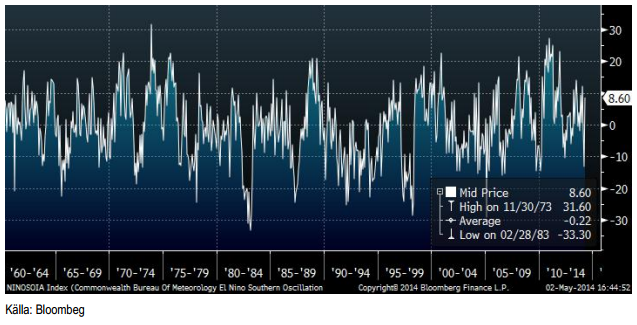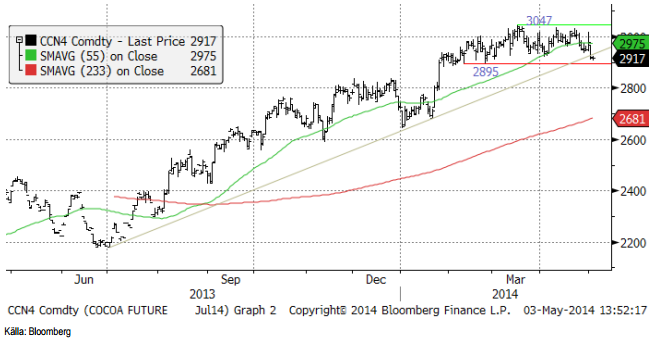Analys
SEB – Råvarukommentarer, 5 maj 2014

Rekommendationer
Kort sammanfattning
Det är verkligen hög tid att köpa ädelmetaller, trots ”tapering” och bra arbetsmarknadsstatistik i USA. Ädelmetallerna har priser som är i nivå med den genomsnittliga produktionskostnaden och oron i Ukraina, dvs mellan Ryssland och Västvärlden är en faktor som kan driva priset uppåt. Vår rangordning av ädelmetallerna är platina, palladium, silver och guld. De två senare är de som normalt brukar efterfrågas vid geopolitisk oro.
Kopparmarknaden har en liknande situation, med ett pris som är i nivå med produktionskostnaden och dessutom sjunkande lager, som nu hunnit bli ganska låga i ett historiskt perspektiv.
Vetepriset handlades upp i fredags efter förnyad oro för situationen i Ukraina. Däremot ser väderleksprognoserna för alla veteodlande regioner utom Kansas och Texas bättre ut än på flera år. Egyptens GASC köpte också vete från Ukraina och Ryssland, där riskpremien för Ukraina var 1% på priset. Det visar att marknaden för vete fokuserar allt för mycket på Ukrainas problem (vädret och vetet är i perfekt skick) och för lite på vad som faktiskt påverkar marknadens utbud och efterfrågan – och därmed priset. Diskrepansen mellan det pris marknaden har bildat genom fel fokus å ena sidan och jordnära realiteter å den andra, gör att vi rekommenderar sälj på vete. Vädret är gynnsamt för majs också. Sådden i USA är inte sen och som utvecklingen i vädret ter sig nu, kan sådden t o m bli snabbare avklarad än normalt.
Råolja – Brent
Oljepriset föll tillbaka i veckan innan det repade sig till 108.59 vid stängning i fredags. Det är de växlande beskeden från Libyen som marknaden handlar på, bland annat.
Råoljelagren i USA nådde rekordnivå. Lagren vid guldkusten är överfulla pga att produktionen ökat mycket mer än pipelinesystemen byggts ut och raffinaderikapaciteten likaså. Därför har det de senaste månaderna talats om att tillåta export av råolja från USA, men det är bättre ekonomi i att raffinera olja till produkter i USA än att exportera olja t ex till EU för att raffinera den här. I USA finns billig naturgas, som dels kan användas för att uppgradera oljan till lättare kolväten och dels användas som värmekälla i processen.
Importen sjönk från förra veckan; högre import var alltså inte heller den här veckan den drivande faktorn bakom de rekordhöga lagren.
Krisen i Ukraina och Libyens problem innebär två saker. För det första skjuts prisfallet i olja lite på framtiden. För det andra stimuleras spridning av fracking ännu mer, vilket innebär att prisfallet blir ännu djupare när det kommer.
Vi rekommenderar en kort position i olja, t ex med MINIS OLJA B S eller MINIS OLJA A S.
Elektricitet
Elpriset gick i veckan över trendlinjen och vi har då enligt det förra veckobrevet en köprekommendation. Väderleksprognosen enligt GFS-modellen (se nedan under odlingsväder) för de norsk-svenska fjällen ser dock blötare ut än normalt. Om det blir en rekyl nedåt i elpriset kan det vara ett bra tillfälle att gå lång marknaden.
Spreaden mellan Phelix Baseload för det tredje kvartalet och Nasdaqs motsvarande har gått i hop 1% sedan förra veckan, från 28% skillnad till 27% skilllnad. Nordisk el är dock fortfarande ”billig” i förhållande till tysk el.
Priset på kol har rört sig uppåt, men utan större dynamik i rörelsen, varför man kan förvänta sig en rekyl nedåt.
Vi har alltså gått över till köprekommendation, men tycker att man helst ska invänta en rekyl nedåt för att köpa till bättre nivå.
Naturgas
Priset på naturgas har hängt sig kvar vid 4.80 dollar per MMBtu. Att priset inte orkat gå högre än pristoppen i februari, trots ytterligare en veckas försök, får tolkas som ytterligare en negativ signal.
Från USA rapporteras att t ex Marcellusfältet producerar mer naturgas än det finns möjlighet att transportera därifrån via pipelines. Fracking har alltså varit mer framgångsrik än vad logistiken hunnit med att ta hand om. Det är en situation som känns igen från den första oljeruschen i Pennsylvania på 1860-talet och från oljeruschen i Iran, Irak i början av 1900-talet och Saudiarabien vid mitten av 1900-talet. Nyckeln till framgång och förmögenhetsbildning flyttas från den glamorösa oljerushen till den tråkiga pipeline-affären.
Koppar
Det börjar uppmärksammas att lagernivåerna fallit ett längre tag och att trenden håller i sig, trots de ganska låga nivåerna i ett historiskt perspektiv. Ett pris på 6500 dollar per ton är vad det kostar att producera koppar hos Codelco i Chile. Dagens priser är därför förmodligen nära botten.
Vi håller fast vid en köprekommendation på koppar.
Aluminium
Förra veckan hade vi neutral på aluminium. Tekniskt har den fallande trenden brutits, men sedan kom veckans kraftiga rekyl. Lagernivåerna är fortfarande mycket höga och det kommer att ta tid, lång tid, att beta av lagren. Priset är nere på en stödnivå efter veckans ras och det är möjligt att det kan komma en rekyl uppåt från den här nivån. Vi gör därför över till kortsiktigt köp, som rekommendation.
Zink
Zinkpriset har sedan kursrusningen under slutet av förra året, etablerat sig i ett prisintervall med det gamla taket som golv. Golvet finns vid ca 1975 dollar och taket vid 2100 dollar. Den långsiktiga trenden är dock uppåtriktad. Man gör bäst i att försöka köpa certifikat på zink nära golvet på prisintervallet, men generellt sett har vi köprekommendation.
Nickel
Nickelpriset har rusat iväg på ett fenomenalt sätt och nådde för en vecka sedan upp till en gammal toppnivå vid 18500 dollar per ton, senast noterad för drygt ett år sedan. Vi kan inte hitta motiv till en så här stor och snabb prisuppgång, även med hänsyn till Indonesiens exportförbud av obearbetad malm och risken för exportproblem från Ryssland. Vi har haft neutral rekommendation under den senare delen av uppgången och går nu över till säljrekommendation.
Guld
Guldpriset fick stöd av den förnyade oron i Ukraina. Vi kallar det som händer för ”oro”, men det handlar i själva verket om krig mellan Ukraina och Ryssland. Dels har gatudemonstranterna på den pro-ryska sidan toppmoderna versioner av AK-47 och dels har de inte bara knölpåkar utan även luftvärnsmissilsystem och kunskap att skjuta träffsäkert med dem. Årsdagen av Rysslands seger i det andra världskriget infaller i veckan som kommer, vilket kan öka entusiasmen från den sidan. Det kan och borde ge guldmarknaden en ökad lyster.
Vi rekommenderar köp av GULD S.
Silver
Silverpriset fann som väntat stöd på 18.9 dollar per finuns. Eftersom silverpriset är lågt i en historisk jämförelse med guldpriset, föredrar vi silver framför guld.
Nedan ser vi ett diagram över priset på guld uttryckt i silver. Det går alltså över 66 finuns silver på varje fin-uns av guld. Som vi ser är det en hög nivå, dvs silver är billigt i förhållande till guld.
Vi anser att silver är mer köpvärt än guld och skulle vilja köpa på de här nivåerna. Vi rekommenderar köp av SILVER S.
Platina & Palladium
Platina påverkades också av ”oroligheterna” i Ukraina, liksom guld och silver. Till platinas fördel talar också den omöjliga situationen i Sydafrika. Gruvbolagen går inte runt och gruvarbetarna vill ha mer betalt. Det kan bara sluta med att det kommer att produceras mindre platina till ett högre pris. Någon annan utgång finns inte.
Den mycket inflytelserika analysfirman GFMS, som nuförtiden är en del av Reuters, publicerade sin årsvisa Platinum and Palladium Survey i fredags. Rapportens innehåll återspeglar samma sak jag sagt länge i det här veckobrevet – lite drygt hälften av gruvorna går med vinst. En stor del gör det inte. Det är inte en långsiktigt hållbar marknadsbalans. Produktionen måste ner. Därmed kommer priset att stiga.
Priset på palladium har också fortsatt att sega sig uppåt. Arbetsmarknadsstatistiken från USA i fredags var oväntat positiv. Fler personer i sysselsättning innebär sannolikt fler bilar och därmed mer palladium i katalysatorer, totalt sett.
Vi rekommenderar köp av PLATINA S och PALLADIUM S, eller BULL PLATINA X4 S eller BULL PALLAD X4 S.
För den som vill ta ännu mer risk, finns nu även BULL PALLAD X5 S.
Kaffe
Ur teknisk synvinkel ser kaffemarknaden ut att ha gått in i en konsolieeringsfas, eller en toppformation. För att behålla den stigande pristrenden måste marknaden ta ut toppen på 220 cent per pund. Det ser marknaden inte ut att vara i begrepp att göra.
När allt fokus har varit på torkan i Brasilien har en ny fara för global kaffeproduktion dykt upp. El Niño väntas slå till i juli och enligt sex av sju klimatmodeller väntas den växa i styrka under hösten. På norra halvklotet börjar skörden av kaffe i september och oktober. El Niño skapar torka i länder som Australien, Indonesien och Vietnamn. De två senare är stora producenter av robusta-kaffe. Nedan ser vi hur Southern Oscillation Index har utvecklat sig sedan 1960. Ett SOI > 8.5 innebär La Niña och SOI < -8.5 innebär El Niño.
Vi tar dessa noteringar och identifierar när det varit torka före skörd i Indonesien och testar statistiskt för effekten på Indonesiens kaffeproduktion dessa år. Jag väljer Indonesien istället för Vietnam, världens största producent, eftersom Vietnams kaffeproduktion blommade ut ganska sent, efter Vietnamnkrigets slut 1975. Indonesien har haft en ganska stabil produktion.
En statistiskt körning visar att Indonesiens produktion minskar med nästan 5% när det varit El Niño och det estimatet är nästan statistiskt signifikant på 5% nivån. I vart fall tillräckligt för att vi ska ta det som helt säkert att det kommer att bli en mindre produktion i år. Detta var alltså Indonesien, men det ser säkerligen likadant ut för Vietnam.
5% mindre produktion av robusta, utöver ett produktionsbortfall på ca 20% från Brasilien bör ha en ytterligare prisdrivande effekt på marknadspriset, även om det rent tekniskt inte ser så ut just nu.
Vi rekommenderar köp av KAFFE S, men man bör ta stoppen om kaffepriset går under 200 cent.
Kakao
Priset på kakao ligger i ett etablerat prisintervall med botten på 2895 och tak på 3047. Dynamiken verkar vara på nedsidan i prisrörelserna, men i fredags fick marknaden stöd när priset var nära botten på prisintervallet. Vi fortsätter med neutral vy till dess golvet vid 2895 inte bryts.
[box]SEB Veckobrev Veckans råvarukommentar är producerat av SEB Merchant Banking och publiceras i samarbete och med tillstånd på Råvarumarknaden.se[/box]
Disclaimer
The information in this document has been compiled by SEB Merchant Banking, a division within Skandinaviska Enskilda Banken AB (publ) (“SEB”).
Opinions contained in this report represent the bank’s present opinion only and are subject to change without notice. All information contained in this report has been compiled in good faith from sources believed to be reliable. However, no representation or warranty, expressed or implied, is made with respect to the completeness or accuracy of its contents and the information is not to be relied upon as authoritative. Anyone considering taking actions based upon the content of this document is urged to base his or her investment decisions upon such investigations as he or she deems necessary. This document is being provided as information only, and no specific actions are being solicited as a result of it; to the extent permitted by law, no liability whatsoever is accepted for any direct or consequential loss arising from use of this document or its contents.
About SEB
SEB is a public company incorporated in Stockholm, Sweden, with limited liability. It is a participant at major Nordic and other European Regulated Markets and Multilateral Trading Facilities (as well as some non-European equivalent markets) for trading in financial instruments, such as markets operated by NASDAQ OMX, NYSE Euronext, London Stock Exchange, Deutsche Börse, Swiss Exchanges, Turquoise and Chi-X. SEB is authorized and regulated by Finansinspektionen in Sweden; it is authorized and subject to limited regulation by the Financial Services Authority for the conduct of designated investment business in the UK, and is subject to the provisions of relevant regulators in all other jurisdictions where SEB conducts operations. SEB Merchant Banking. All rights reserved.
Analys
Crude oil soon coming to a port near you

Rebounding along with most markets. But concerns over solidity of Gaza peace may also contribute. Brent crude fell 0.8% yesterday to $61.91/b and its lowest close since May this year. This morning it is bouncing up 0.9% to $62.5/b along with a softer USD amid positive sentiment with both equities and industrial metals moving higher. Concerns that the peace in Gaza may be less solid than what one might hope for also yields some support to Brent. Bets on tech stocks are rebounding, defying fears of trade war. Money moving back into markets. Gold continues upwards its strong trend and a softer dollar helps it higher today as well.

US crude & products probably rose 5.6 mb last week (API) versus a normal seasonal decline of 2.4 mb. The US API last night partial and thus indicative data for US oil inventories. Their data indicates that US crude stocks rose 7.4 mb last week, gasoline stocks rose 3.0 mb while Distillate stocks fell 4.8 mb. Altogether an increase in commercial crude and product stocks of 5.6 mb. Commercial US crude and product stocks normally decline by 2.4 mb this time of year. So seasonally adjusted the US inventories rose 8 mb last week according to the indicative numbers by the API. That is a lot. Also, the counter seasonal trend of rising stocks versus normally declining stocks this time of year looks on a solid pace of continuation. If the API is correct then total US crude and product stocks would stand 41 mb higher than one year ago and 6 mb higher than the 2015-19 average. And if we combine this with our knowledge of a sharp increase in production and exports by OPEC(+) and a large increase in oil at sea, then the current trend in US oil inventories looks set to continue. So higher stocks and lower crude oil prices until OPEC(+) switch to cuts. Actual US oil inventory data today at 18:00 CET.
US commercial crude and product stocks rising to 1293 mb in week 41 if last nights indicative numbers from API are correct.

Crude oil soon coming to a port near you. OPEC has lifted production sharply higher this autumn. At the same time demand for oil in the Middle-East has fallen as we have moved out of summer heat and crude oil burn for power for air-conditioning. The Middle-East oil producers have thus been able to lift exports higher on both accounts. Crude oil and condensates on water has shot up by 177 mb since mid-August. This oil is now on its way to ports around the world. And when they arrive, it will likely help to lift stocks onshore higher. That is probably when we will lose the last bit of front-end backwardation the the crude oil curves. That will help to drive the front-month Brent crude oil price down to the $60/b line and revisit the high $50ies/b. Then the eyes will be all back on OPEC+ when they meet in early November and then again in early December.
Crude oil and condensates at sea have moved straight up by 177 mb since mid-August as OPEC(+) has produced more, consumed less and exported more.

Analys
The Mid-East anchor dragging crude oil lower

When it starts to move lower it moves rather quickly. Gaza, China, IEA. Brent crude is down 2.1% today to $62/b after having traded as high as $66.58/b last Thursday and above $70/b in late September. The sell-off follows the truce/peace in Gaze, a flareup in US-China trade and yet another bearish oil outlook from the IEA.

A lasting peace in Gaze could drive crude oil at sea to onshore stocks. A lasting peace in Gaza would probably calm down the Houthis and thus allow more normal shipments of crude oil to sail through the Suez Canal, the Red Sea and out through the Bab-el-Mandeb Strait. Crude oil at sea has risen from 48 mb in April to now 91 mb versus a pre-Covid normal of about 50-60 mb. The rise to 91 mb is probably the result of crude sailing around Africa to be shot to pieces by the Houthis. If sailings were to normalize through the Suez Canal, then it could free up some 40 mb in transit at sea moving onshore into stocks.
The US-China trade conflict is of course bearish for demand if it continues.
Bearish IEA yet again. Getting closer to 2026. Credibility rises. We expect OPEC to cut end of 2025. The bearish monthly report from the IEA is what it is, but the closer we get to 2026, the more likely the IEA is of being ball-park right in its outlook. In its monthly report today the IEA estimates that the need for crude oil from OPEC in 2026 will be 25.4 mb/d versus production by the group in September of 29.1 mb/d. The group thus needs to do some serious cutting at the end of 2025 if it wants to keep the market balanced and avoid inventories from skyrocketing. Given that IEA is correct that is. We do however expect OPEC to implement cuts to avoid a large increase in inventories in Q1-26. The group will probably revert to cuts either at its early December meeting when they discuss production for January or in early January when they discuss production for February. The oil price will likely head yet lower until the group reverts to cuts.
Dubai: The Mid-East anchor dragging crude oil lower. Surplus emerging in Mid-East pricing. Crude oil prices held surprisingly strong all through the summer. A sign and a key source of that strength came from the strength in the front-end backwardation of the Dubai crude oil curve. It held out strong from mid-June and all until late September with an average 1-3mth time-spread premium of $1.8/b from mid-June to end of September. The 1-3mth time-spreads for Brent and WTI however were in steady deterioration from late June while their flat prices probably were held up by the strength coming from the Persian Gulf. Then in late September the strength in the Dubai curve suddenly collapsed. Since the start of October it has been weaker than both the Brent and the WTI curves. The Dubai 1-3mth time-spread now only stands at $0.25/b. The Middle East is now exporting more as it is producing more and also consuming less following elevated summer crude burn for power (Aircon) etc.
The only bear-element missing is a sudden and solid rise in OECD stocks. The only thing that is missing for the bear-case everyone have been waiting for is a solid, visible rise in OECD stocks in general and US oil stocks specifically. So watch out for US API indications tomorrow and official US oil inventories on Thursday.
No sign of any kind of fire-sale of oil from Saudi Arabia yet. To what we can see, Saudi Arabia is not at all struggling to sell its oil. It only lowered its Official Selling Prices (OSPs) to Asia marginally for November. A surplus market + Saudi determination to sell its oil to the market would normally lead to a sharp lowering of Saudi OSPs to Asia. Not yet at least and not for November.
The 5yr contract close to fixed at $68/b. Of importance with respect to how far down oil can/will go. When the oil market moves into a surplus then the spot price starts to trade in a large discount to the 5yr contract. Typically $10-15/b below the 5yr contract on average in bear-years (2009, 2015, 2016, 2020). But the 5yr contract is usually pulled lower as well thus making this approach a moving target. But the 5yr contract price has now been rock solidly been pegged to $68/b since 2022. And in the 2022 bull-year (Brent spot average $99/b), the 5yr contract only went to $72/b on average. If we assume that the same goes for the downside and that 2026 is a bear-year then the 5yr goes to $64/b while the spot is trading at a $10-15/b discount to that. That would imply an average spot price next year of $49-54/b. But that is if OPEC doesn’t revert to cuts and instead keeps production flowing. We think OPEC(+) will trim/cut production as needed into 2026 to prevent a huge build-up in global oil stocks and a crash in prices. But for now we are still heading lower. Into the $50ies/b.
Analys
More weakness and lower price levels ahead, but the world won’t drown in oil in 2026

Some rebound but not much. Brent crude rebounded 1.5% yesterday to $65.47/b. This morning it is inching 0.2% up to $65.6/b. The lowest close last week was on Thursday at $64.11/b.

The curve structure is almost as week as it was before the weekend. The rebound we now have gotten post the message from OPEC+ over the weekend is to a large degree a rebound along the curve rather than much strengthening at the front-end of the curve. That part of the curve structure is almost as weak as it was last Thursday.
We are still on a weakening path. The message from OPEC+ over the weekend was we are still on a weakening path with rising supply from the group. It is just not as rapidly weakening as was feared ahead of the weekend when a quota hike of 500 kb/d/mth for November was discussed.
The Brent curve is on its way to full contango with Brent dipping into the $50ies/b. Thus the ongoing weakening we have had in the crude curve since the start of the year, and especially since early June, will continue until the Brent crude oil forward curve is in full contango along with visibly rising US and OECD oil inventories. The front-month Brent contract will then flip down towards the $60/b-line and below into the $50ies/b.
At what point will OPEC+ turn to cuts? The big question then becomes: When will OPEC+ turn around to make some cuts? At what (price) point will they choose to stabilize the market? Because for sure they will. Higher oil inventories, some more shedding of drilling rigs in US shale and Brent into the 50ies somewhere is probably where the group will step in.
There is nothing we have seen from the group so far which indicates that they will close their eyes, let the world drown in oil and the oil price crash to $40/b or below.
The message from OPEC+ is also about balance and stability. The world won’t drown in oil in 2026. The message from the group as far as we manage to interpret it is twofold: 1) Taking back market share which requires a lower price for non-OPEC+ to back off a bit, and 2) Oil market stability and balance. It is not just about 1. Thus fretting about how we are all going to drown in oil in 2026 is totally off the mark by just focusing on point 1.
When to buy cal 2026? Before Christmas when Brent hits $55/b and before OPEC+ holds its last meeting of the year which is likely to be in early December.
Brent crude oil prices have rebounded a bit along the forward curve. Not much strengthening in the structure of the curve. The front-end backwardation is not much stronger today than on its weakest level so far this year which was on Thursday last week.

The front-end backwardation fell to its weakest level so far this year on Thursday last week. A slight pickup yesterday and today, but still very close to the weakest year to date. More oil from OPEC+ in the coming months and softer demand and rising inventories. We are heading for yet softer levels.

-

 Nyheter3 veckor sedan
Nyheter3 veckor sedanOPEC+ missar produktionsmål, stöder oljepriserna
-

 Nyheter4 veckor sedan
Nyheter4 veckor sedanEtt samtal om guld, olja, fjärrvärme och förnybar energi
-

 Nyheter2 veckor sedan
Nyheter2 veckor sedanGoldman Sachs höjer prognosen för guld, tror priset når 4900 USD
-

 Nyheter2 veckor sedan
Nyheter2 veckor sedanGuld nära 4000 USD och silver 50 USD, därför kan de fortsätta stiga
-

 Nyheter3 veckor sedan
Nyheter3 veckor sedanBlykalla och amerikanska Oklo inleder ett samarbete
-

 Analys4 veckor sedan
Analys4 veckor sedanAre Ukraine’s attacks on Russian energy infrastructure working?
-

 Nyheter4 veckor sedan
Nyheter4 veckor sedanGuldpriset uppe på nya höjder, nu 3750 USD
-

 Nyheter3 veckor sedan
Nyheter3 veckor sedanEtt samtal om guld, olja, koppar och stål


